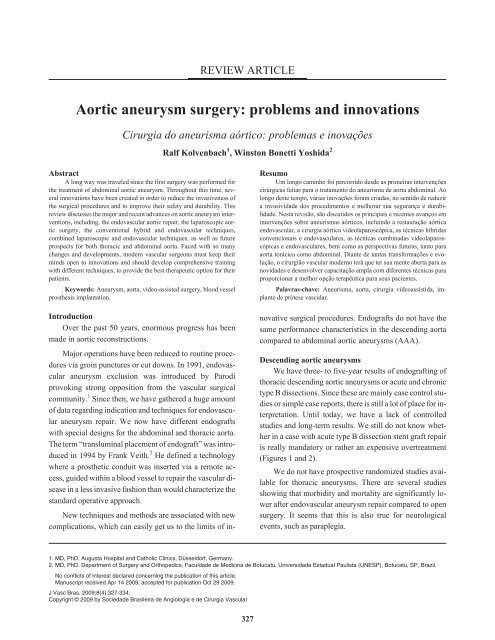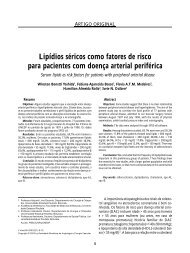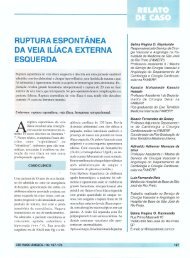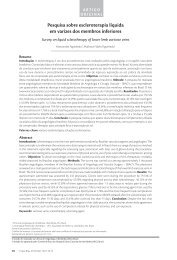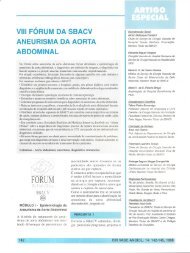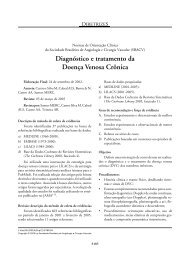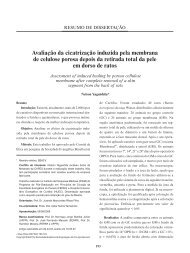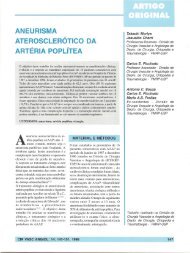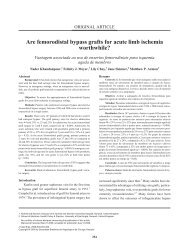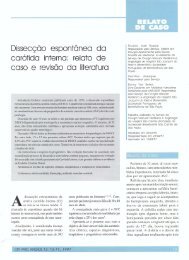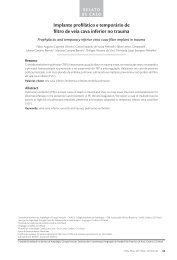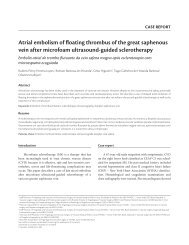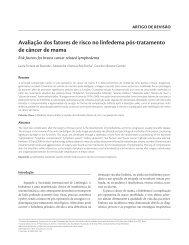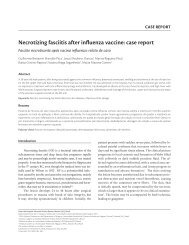Aortic aneurysm surgery: problems and innovations
Aortic aneurysm surgery: problems and innovations
Aortic aneurysm surgery: problems and innovations
You also want an ePaper? Increase the reach of your titles
YUMPU automatically turns print PDFs into web optimized ePapers that Google loves.
REVIEW ARTICLE<strong>Aortic</strong> <strong>aneurysm</strong> <strong>surgery</strong>: <strong>problems</strong> <strong>and</strong> <strong>innovations</strong>Cirurgia do aneurisma aórtico: problemas e inovaçõesRalf Kolvenbach 1 , Winston Bonetti Yoshida 2AbstractA long way was traveled since the first <strong>surgery</strong> was performed forthe treatment of abdominal aortic <strong>aneurysm</strong>. Throughout this time, several<strong>innovations</strong> have been created in order to reduce the invasiveness ofthe surgical procedures <strong>and</strong> to improve their safety <strong>and</strong> durability. Thisreview discusses the major <strong>and</strong> recent advances on aortic <strong>aneurysm</strong> interventions,including, the endovascular aortic repair, the laparoscopic aortic<strong>surgery</strong>, the conventional hybrid <strong>and</strong> endovascular techniques,combined laparoscopic <strong>and</strong> endovascular techniques, as well as futureprospects for both thoracic <strong>and</strong> abdominal aorta. Faced with so manychanges <strong>and</strong> developments, modern vascular surgeons must keep theirminds open to <strong>innovations</strong> <strong>and</strong> should develop comprehensive trainingwith different techniques, to provide the best therapeutic option for theirpatients.Keywords: Aneurysm, aorta, video-assisted <strong>surgery</strong>, blood vesselprosthesis implantation.ResumoUm longo caminho foi percorrido desde as primeiras intervençõescirúrgicas feitas para o tratamento do aneurisma de aorta abdominal. Aolongo deste tempo, várias inovações foram criadas, no sentido de reduzira invasividade dos procedimentos e melhorar sua segurança e durabilidade.Nesta revisão, são discutidos os principais e recentes avanços emintervenções sobre aneurismas aórticos, incluindo a restauração aórticaendovascular, a cirurgia aórtica videolaparoscópica, as técnicas híbridasconvencionais e endovasculares, as técnicas combinadas videolaparoscópicase endovasculares, bem como as perspectivas futuras, tanto paraaorta torácica como abdominal. Diante de tantas transformações e evolução,o cirurgião vascular moderno terá que ter sua mente aberta para asnovidades e desenvolver capacitação ampla com diferentes técnicas paraproporcionar a melhor opção terapêutica para seus pacientes.Palavras-chave: Aneurisma, aorta, cirurgia videoassistida, implantede prótese vascular.IntroductionOver the past 50 years, enormous progress has beenmade in aortic reconstructions.Major operations have been reduced to routine proceduresvia groin punctures or cut downs. In 1991, endovascular<strong>aneurysm</strong> exclusion was introduced by Parodiprovoking strong opposition from the vascular surgicalcommunity. 1 Since then, we have gathered a huge amountof data regarding indication <strong>and</strong> techniques for endovascular<strong>aneurysm</strong> repair. We now have different endograftswith special designs for the abdominal <strong>and</strong> thoracic aorta.The term “transluminal placement of endograft” was introducedin 1994 by Frank Veith. 2 He defined a technologywhere a prosthetic conduit was inserted via a remote access,guided within a blood vessel to repair the vascular diseasein a less invasive fashion than would characterize thest<strong>and</strong>ard operative approach.New techniques <strong>and</strong> methods are associated with newcomplications, which can easily get us to the limits of innovativesurgical procedures. Endografts do not have thesame performance characteristics in the descending aortacompared to abdominal aortic <strong>aneurysm</strong>s (AAA).Descending aortic <strong>aneurysm</strong>sWe have three- to five-year results of endografting ofthoracic descending aortic <strong>aneurysm</strong>s or acute <strong>and</strong> chronictype B dissections. Since these are mainly case control studiesor simple case reports, there is still a lot of place for interpretation.Until today, we have a lack of controlledstudies <strong>and</strong> long-term results. We still do not know whetherin a case with acute type B dissection stent graft repairis really m<strong>and</strong>atory or rather an expensive overtreatment(Figures 1 <strong>and</strong> 2).We do not have prospective r<strong>and</strong>omized studies availablefor thoracic <strong>aneurysm</strong>s. There are several studiesshowing that morbidity <strong>and</strong> mortality are significantly lowerafter endovascular <strong>aneurysm</strong> repair compared to open<strong>surgery</strong>. It seems that this is also true for neurologicalevents, such as paraplegia.1. MD, PhD. Augusta Hospital <strong>and</strong> Catholic Clinics, Düsseldorf, Germany.2. MD, PhD. Department of Surgery <strong>and</strong> Orthopedics, Faculdade de Medicina de Botucatu, Universidade Estadual Paulista (UNESP), Botucatu, SP, Brazil.No conflicts of interest declared concerning the publication of this article.Manuscript received Apr 14 2009, accepted for publication Oct 29 2009.J Vasc Bras. 2009;8(4):327-334.Copyright © 2009 by Sociedade Brasileira de Angiologia e de Cirurgia Vascular327
328 J Vasc Bras 2009, Vol. 8, N° 4 <strong>Aortic</strong> <strong>aneurysm</strong> <strong>surgery</strong> - Kolvenbach R & Yoshida WBHowever, paraplegia can still occur in up to 4% of thosepatients stented for descending thoracic aortic <strong>aneurysm</strong>s(TAA). Figure 3 shows a Crawford type II TAAwith a widely patent great radicular artery of Adamkiewicz.The patient was operated using an open approachwith reimplantation of the intercostals arteries. He had anuneventful recovery without any neurological <strong>problems</strong>.Abdominal aortic <strong>aneurysm</strong>sEndovascular <strong>surgery</strong> is minimal invasive because ofreduced access trauma. More importantly, we do not haveprolonged ischemia times with subsequent ischemia/reperfusioninjury. Yet we still have severe complicationsincluding graft migration <strong>and</strong> rupture. Therefore we owe itto our patients to discuss the pros <strong>and</strong> cons of the minimalinvasive procedure critically. Patients with large <strong>aneurysm</strong>s(> 5.5 cm) do have a higher incidence of rupturethan patients with smaller <strong>aneurysm</strong>s (< 5.5 cm): 6.1 vs.1.5%. This must be discussed when considering the spontaneouscourse of small <strong>aneurysm</strong>s. 3,4 According to theU.K. Small Aneurysm Trial, 5 the incidence of rupture isless than 1% per year in <strong>aneurysm</strong>s < 5.5 cm. Therefore thecost/benefit ratio must be taken into account when presentingtreatment options to <strong>aneurysm</strong> patients. Yet morphologyof small <strong>aneurysm</strong>s is much more favorable for anFigure 1 - Descending thoracic aortic <strong>aneurysm</strong> after type B dissectionFigure 2 - Stent graft excludes <strong>aneurysm</strong> of the thoracic aortaFigure 3 - Preoperative angio-CT scan with intercostal artery
<strong>Aortic</strong> <strong>aneurysm</strong> <strong>surgery</strong> - Kolvenbach R & Yoshida WB J Vasc Bras 2009, Vol. 8, N° 4 329endovascular procedure in small AAA than in large aortic<strong>aneurysm</strong>s. Ongoing prospective r<strong>and</strong>omized studies willshow whether prophylactic stenting will be a treatment option.This idea will certainly not be shared by most healthcare providers.A major problem is the cost associated with endovascular<strong>aneurysm</strong> repair. Probably this is one reason why theauthors of the Endovascular <strong>Aortic</strong> Repair (EVAR)-1-Study conclude that EVAR should only be introduced intodaily clinical practice when long-term results will becomeavailable. 3,4<strong>Aortic</strong> morphology is critical in determining the successfuloutcome of EVAR. Inadequate proximal aorticneck is most often the criteria for exclusion of EVAR. 6 Patientswith short, heavily calcified aneurismal neck <strong>and</strong>large <strong>aneurysm</strong> are at increased risk of proximal type I endoleaks<strong>and</strong> an ongoing risk of rupture. Endografting ofAAA in patients with complicated neck anatomy is associatedwith a greater incidence of adverse renal events. Becausedifficult aortic neck morphology is associated withincreased device migration, type I <strong>and</strong> II endoleaks, <strong>and</strong> renalinsufficiency, it compromises the successful outcomeof EVAR.Hybrid techniquesA lot of patients, especially with large <strong>aneurysm</strong>s donot have an adequate l<strong>and</strong>ing zone. In these cases, eitherconventional <strong>surgery</strong> is required or fenestrated or branchedgrafts can be used. Both techniques, taking in accounttheir short-term results, are still considered to be more orless experimental. There is still a significant incidence ofthrombosis of the renal or visceral branches with severeconsequences which include the complete loss of a originallywell functioning kidney. Alternatively, so calledhybrid techniques can be used. This simply means a combinationof conventional bypass <strong>surgery</strong> <strong>and</strong> endovasculartherapy. Patients with thoracoabdominal <strong>aneurysm</strong>s can betreated with an endovascular graft in combination withmultiple bypasses to the visceral <strong>and</strong> renal arteries (Figures4 <strong>and</strong> 5). With this hybrid technique there is no need fora thoracotomy with a subsequent smoother postoperativecourse <strong>and</strong> reduced ischemia time.Hybrid techniques can also be used as a less invasivealternative for aortic arch repair (Figure 6). The techniqueis associated with debranching of the supra-aortic vesselsFigure 4 - Complete debranching of the visceral <strong>and</strong> the renal arteries:A) ilio-renal bypass originating from the right iliac artery;B) modified bifurcated graft revascularizes the left renal artery<strong>and</strong> the visceral vesselsFigure 5 - Increased l<strong>and</strong>ing zone after aorto-hepatic bypass topermit overstenting of the celiac trunkwithout any need for cardiopulmonary bypass, thus reducingthe incidence of cerebral complications. Consideringthe significant morbidity <strong>and</strong> mortality with neurological<strong>problems</strong> between 12 <strong>and</strong> 40% after conventional aorticarch repair, we can see that here is still a lot of place for improvement<strong>and</strong> definitely a role for less invasive endovascularprocedures. In contrast to other authors, we do notbelieve that routine covering of the origin of the left sub-
330 J Vasc Bras 2009, Vol. 8, N° 4 <strong>Aortic</strong> <strong>aneurysm</strong> <strong>surgery</strong> - Kolvenbach R & Yoshida WBwho today is well informed has the right to select less provenbut minimally invasive, cutting-edge technology withfewer immediate risks even if conventional open <strong>surgery</strong> ismore established <strong>and</strong> obviously more durable. The needfor repeat interventions because of early failure appears tobe less of a problem for many patients than previouslythought, as long as the procedure poses minimal risk. Openvascular <strong>surgery</strong> is still needed in almost all areas of vascular<strong>surgery</strong>. This is supported by level 1 evidence providedby recently published prospective r<strong>and</strong>omized multicenterstudies. The British clinical trial EVAR-1 found no survivaldifference at 4 years between open <strong>and</strong> endovascularrepair of AAA. The EVAR-2 trial found no advantage ofstent grafts over observation in high risk patients who underwentendovascular <strong>aneurysm</strong> repair, <strong>and</strong> the smallerDutch DREAM trial also failed to find survival differenceat 3 years between those who underwent endovascular treatment<strong>and</strong> those who had open surgical repair. 3,4 In addition,it will be another 4 years when the PIVOTAL study iscompleted, until we find out whether endovascular repairis justified in patients with small aortic <strong>aneurysm</strong>s. Evenenthusiastic proponents of endovascular therapy admitthat 6 years from now, there will still be plenty of open vascular<strong>surgery</strong>.Figure 6 - <strong>Aortic</strong> arch saccular <strong>aneurysm</strong> suitable for debranching<strong>surgery</strong>clavian artery is advisable. There are some anecdotal datathat this can increase the incidence of paraplegia after endograftingof the descending thoracic aorta by shutting offthe internal thoracic artery as a collateral pathway. Offpumpvascular <strong>surgery</strong> can only be performed in close collaborationbetween vascular surgeons, radiologists, <strong>and</strong>anesthetists.The role of EVAR todayThere is no doubt that endovascular aortic <strong>surgery</strong> isbecoming the first line of treatment in patients with aorticdisease <strong>and</strong> even in ruptured <strong>aneurysm</strong>s. 7-9 Though in rupturedcases there is quite often no adequate proximal l<strong>and</strong>ingzone because of the diameter of the infrarenal aorta.Since there is a lot enthusiasm from patients <strong>and</strong> frommedical device manufacturers we can be sure that endovascular<strong>aneurysm</strong> exclusion is here to stay irrespective ofrecent studies <strong>and</strong> publications. 10-16 Principally, a patientLaparoscopic aortic <strong>surgery</strong>In a number of centers, especially in Canada, France,Italy <strong>and</strong> some other European countries, laparoscopicaortic <strong>surgery</strong> emerged as the third less invasive way. 17-28Like in any other laparoscopic procedures, we have a reducedaccess trauma, but we still have the problem of ischemia/reperfusioninjury due to aortic clamping times whichare still longer compared to open <strong>surgery</strong>. It may be expectedthat the outcome of laparoscopic resection for instanceof AAA is equivalent to the gold st<strong>and</strong>ards, a transperitonealtube graft repair, simply because the conventionaloperation is performed laparoscopically. Total laparoscopicaortic procedures can be performed in patients with occlusivedisease, as well as in <strong>aneurysm</strong> cases. Basicprinciple of a total laparoscopic operation is that the anastomosisis performed with laparoscopic needle holders underpneumoperitoneum.Basically, we can implement laparoscopic techniquesin three ways in aortic <strong>surgery</strong>.
332 J Vasc Bras 2009, Vol. 8, N° 4 <strong>Aortic</strong> <strong>aneurysm</strong> <strong>surgery</strong> - Kolvenbach R & Yoshida WBof type II endoleaks. Theoretically, evacuation of thrombuscould destabilize the endograft <strong>and</strong> weaken the outershell of the <strong>aneurysm</strong>. However, we hope that wrapping ofthe sac around the endograft, similar to a Creech procedure,will accelerate the graft incorporation <strong>and</strong> <strong>aneurysm</strong>sac reduction. Thirdly, proximal fixation of endograft is ofcritical importance in determining the successful outcomeof EVAR. In a study of Talent stent-grafts for patients withlarge infrarenal aortic neck, 17.5% of the devices exhibiteddistal migration during a 17-month follow-up. 40,41 Betterfixation <strong>and</strong> b<strong>and</strong>ing of the endograft to the aorta couldprevent device migration <strong>and</strong> reduce aortic neck dilatation,respectively. 42 Using special suturing techniques, the endoprosthesisis secured to the aortic wall. This may becombined with a b<strong>and</strong>ing procedure to enlarge the l<strong>and</strong>ingzone <strong>and</strong> to prevent neck dilatation.So-called hybrid techniques can also be used in morecomplex <strong>aneurysm</strong>s involving the suprarenal aorta or inthoracoabdominal aortic <strong>aneurysm</strong>s. In these cases, aorticdebranching is performed laparoscopically with the helpof a mini-incision. Subsequently, the <strong>aneurysm</strong> is excludedwith stent grafts. This avoids the need for cost expensivebranched grafts probably offering to the patients a moredurable alternative with less long-term complications. Oneproblem is that only younger vascular surgeons have beentrained in laparoscopic techniques <strong>and</strong> many older vascularsurgeons who have merely acquired the necessary endovascularskills lack any video-endoscopic exposure <strong>and</strong>training. This is associated with a certain fear to adopt onceagain a completely new technique. Another even more importantfactor is the quite cumbersome total laparoscopicanastomosis after successful exposure of the aorta.Future perspectivesIn the near future vascular stapling devices will be onthe market, which similar to colorectal <strong>surgery</strong>, have a potentialto replace a h<strong>and</strong>-sawn anastomosis. Stapling technologywill also permit endovascular exclusion of <strong>aneurysm</strong>swith a short neck preventing graft migration <strong>and</strong>subsequent conversion to open <strong>surgery</strong>.With stapling technology on the horizon, it should bepossible to reduce clamping time in open <strong>surgery</strong> to a fewminutes (Figure 8).Robotic <strong>surgery</strong> is also trying to find a place in laparoscopicprocedures – a tool looking for an application asFigure 8 - Laparoscopic aortic stapler with bifurcated graft: a horizonto reduce clamping time in open <strong>surgery</strong>was recently outlined in an editorial. 43 The Da Vinci robothas already been used in several centers to perform aortofemoralbypass <strong>surgery</strong>. The device is mainly used for suturingthe protheto-aortic anastomosis rather than merelyas a dissection tool. A surgical robot is actually a collectionof wristed “servant” tools called manipulators, which receivedigital instructions from an interfaced computer. The“master” surgeon, seated at an ergonomically designed videoconsole with an “immersive” three-dimensional display,initiates the digital instructions by controlling sophisticatedh<strong>and</strong> grips – essentially, joysticks with sevendegrees of freedom. 43Costs are a more than essential issue. A robot can costUS$1 million or more, not including the maintenance contract<strong>and</strong> the expensive disposable items required for eachprocedure. Its instruments do not provide a sense of touch.The learning curve for the effective use of these tools islong <strong>and</strong> steep. The robot’s toolbox is not very full, <strong>and</strong> thetime required to switch from one instrument to anotherlengthens operating time. Most of all, the majority of publishedstudies of robot-assisted <strong>surgery</strong> have really beentechnical notes describing feasibility. Prospective studiescomparing robotic with conventional procedures will beneeded in order to establish a clear benefit. 43Pharmacological treatment particularly of small <strong>aneurysm</strong>smight soon present another promising treatment
<strong>Aortic</strong> <strong>aneurysm</strong> <strong>surgery</strong> - Kolvenbach R & Yoshida WB J Vasc Bras 2009, Vol. 8, N° 4 333option. 44 The degradation of extracellular-matrix proteinselastin <strong>and</strong> collagen in the aortic wall is critical to the pathogenesisof aortic <strong>aneurysm</strong>s. A process which in part canbe inhibited by administering the antibiotic amoxicillin yetwith all the side effects of a long-term antibiotic treatment.The metallo-proteinases 2.8 <strong>and</strong> 9 have been identified ascrucial in the degradation of elastin. A recent experimentalstudy indicates that inhibition of the stress-activated proteinkinase, Jun N-terminal kinase (JNK) can effectivelyprevent <strong>aneurysm</strong> growth <strong>and</strong> can cause even regression ofalready existing <strong>aneurysm</strong>s. 45ConclusionIn conclusion, these days we see radical changes howaortic <strong>aneurysm</strong>s are treated in daily clinical practice. Sincethe first <strong>aneurysm</strong> resection by Dubost only few changescould be observed over a period of more than 30 years.This is now changing rapidly. The only question will bewhether vascular surgeons will be among those who willdetermine which treatment option will be chosen for ourpatients. This requires an open mind for innovative evolvingtherapies.References1. Parodi JC, Palmaz JC, Barone HD. Transfemoral intraluminalgraft implantation for abdominal aortic <strong>aneurysm</strong>s.Ann Vasc Surg. 1991;5:491-9.2. Veith FJ. Transluminally placed endovascular stented grafts<strong>and</strong> their impact on vascular <strong>surgery</strong>. J Vasc Surg.1994;20:855-60.3. EVAR Trial participants. Endovascular <strong>aneurysm</strong> repair versusopen repair in patients with abdominal aortic <strong>aneurysm</strong>s(EVAR trial 1): r<strong>and</strong>omised controlled trial. Lancet.2005;365:2179-86.4. Blankensteijn JD, Jong SE, Prinssen M, et al. Two-year outcomesafter conventional or endovascular repair of abdominalaortic <strong>aneurysm</strong>s. N Engl J Med. 2005;352:2398-405.5. Schermerhorn ML, Cronenwett JL. The UK small <strong>aneurysm</strong>trial. J Vasc Surg. 2001;33:443.6. DeVirgilio C, Bui H, Donayre C, et al. Endovascular vs openabdominal aortic <strong>aneurysm</strong> repair. a comparison of cardiacmorbidity <strong>and</strong> mortality. Arch Surg. 1999;134:947-50; discussion950-1.7. Beebe HG, Cronenwett JL, Katzen BT, Brewster DC, GreenRM; Vanguard Endograft Trial Investigators. Results of anaortic endograft trial: impact of device failure beyond 12months. J Vasc Surg. 2001;33:S55-63.8. Zarins CK, Arko FR, Lee WA, et al. Effectiveness of endovascularversus open repair in prevention of <strong>aneurysm</strong> relateddeath. In: Proceedings of the 49th Scientific Meeting of theAmerican Association for Vascular Surgery; 2001; Baltimore,MD, USA.9. Zarins CK, Arko FR, Lee WA, et al. Effectiveness of endovascularversus open repair in prevention of <strong>aneurysm</strong> relateddeath. In: Proceedings of the 49th Scientific Meeting of theAmerican Association for Vascular Surgery; 2001; Baltimore,MD, USA.10. Harris PL, Vallabhaneni SR, Desgranges P, Becquemin JP,van Marrewijk C, Laheij RJ. Incidence <strong>and</strong> risk factors of laterupture, conversion, <strong>and</strong> death after endovascular repair ofinfrarenal aortic <strong>aneurysm</strong>s: the EUROSTAR experience. JVasc Surg. 2000;32:739-49.11. White GH, Yu W, May J, et al. Endoleaks as a complicationof endoluminal grafting of abdominal aortic <strong>aneurysm</strong>: classification,incidence, diagnosis, <strong>and</strong> management. J EndovascSurg. 1997;4:152-68.12. Veith FJ, Baum RA, Ohki T, et al. Nature <strong>and</strong> significance ofendoleaks <strong>and</strong> endotension: summary of opinions expressedat an international conference. J Vasc Surg.2002;35:1029-35.13. Matsumura JS, Moore WS. Clinical consequences of periprostheticleak after endovascular repair of abdominal aortic<strong>aneurysm</strong>. J Vasc Surg. 1998;27:606-13.14. Sonesson B, Malina M, Ivancev K, Lindh M, Lindblad B,Brunkwall J. Dilatation of the infrarenal <strong>aneurysm</strong> neck afterendovascular exclusion of abdominal aortic <strong>aneurysm</strong>. J EndovascSurg. 1998;5:195-200.15. Zarins CK, White RA, Fogarty TJ. Aneurysm rupture afterendovascular repair using the AneuRx stent graft. J VascSurg. 2000;31:960-70.16. Schlensak C, Doenst T, Hauer M, et al. Serious complicationsthat require surgical interventions after endoluminalstent-graft placement for the treatment of infrarenal aortic<strong>aneurysm</strong>s. J Vasc Surg. 2001;34:198-203.17. Dion YM, Gracia CR, El Kadi HH. Totally laparoscopic abdominalaortic <strong>aneurysm</strong> repair. J Vasc Surg. 2001;33:181-5.18. Coggia M, Bourriez A, Javerliat I, Goeau-Brissonniere O.Totally laparoscopic aortobifemoral bypass: a new <strong>and</strong> simplifiedapproach. Eur J Vasc Endovasc Surg. 2002;24:274-5.19. Da Silva L, Kolvenbach R, Pinter L. The feasibility of h<strong>and</strong>assistedlaparoscopic bypass using a low transverse incision.Surg Endosc. 2002;16:173-6.20. Kolvenbach R, Ceshire N, Pinter L, Da Silva L, Deling O,Kasper AS. Laparoscopy-assisted <strong>aneurysm</strong> resection as aminimal invasive alternative in patients unsuitable for endovascular<strong>surgery</strong>. J Vasc Surg. 2001;34:216-21.21. Wisselink W, Cuesta M, Gracia C, Rauwerda J. Robotassistedlaparoscopic aortobifemoral bypass for aortoiliacocclusive disease: a report of two cases. J Vasc Surg.2002;36:1079-82.22. Kolvenbach R, Schwierz E. Combined endovascular / laparoscopicapproach to aortic pseudo<strong>aneurysm</strong> repair. J EndovascSurg. 1998;5:191-3.23. Kolvenbach R, Pinter L, Raghun<strong>and</strong>an M, Cheshire N, RamadanH, Dion YM. Laparoscopic remodeling of abdominalaortic <strong>aneurysm</strong>s after endovascular exclusion: a technicaldescription. J Vasc Surg. 2002;36:1267-70.24. Alimi YS, Di Molfetta L, Hartung O, et al. Laparoscopyassistedabdominal aortic <strong>aneurysm</strong> endo<strong>aneurysm</strong>orraphy:early <strong>and</strong> mid-term results. J Vasc Surg. 2003;37:744-9.
334 J Vasc Bras 2009, Vol. 8, N° 4 <strong>Aortic</strong> <strong>aneurysm</strong> <strong>surgery</strong> - Kolvenbach R & Yoshida WB25. Kolvenbach R, Da Silva L, Deling O, Schwierz E. Videoassistedaortic <strong>surgery</strong>. J Am Coll Surg. 2000;190:451-7.26. Kolvenbach R, Deling O, Schwierz E, L<strong>and</strong>ers B. Reducingthe operative trauma in aortoiliac reconstructions - a prospectivestudy to evaluate the role of video-assisted vascular <strong>surgery</strong>.Euro J Vasc Endovasc Surg. 1998;15:483-8.27. Lin JC, Kolvenbach R, Wassiljew S, Pinter L, Schwierz E,Puerschel A. Totally laparoscopic explantation of migratedstent graft after endovascular <strong>aneurysm</strong> repair: a report oftwo cases. J Vasc Surg. 2005;41:885-8.28. Kolvenbach R, Schwierz E, Wasilljew S, Miloud A,Puerschel A, Pinter L. Total laparoscopically <strong>and</strong> roboticallyassisted aortic <strong>aneurysm</strong> <strong>surgery</strong>: a critical evaluation. J VascSurg. 2004;39:771-6.29. Laheij RJ, Buth J, Harris PL, Moll FL, Stelter WJ, VerhoevenEL. Need for secondary interventions after endovascular repairof abdominal aortic <strong>aneurysm</strong>s. Intermediate-term follow-upresults of a European collaborative registry(EUROSTAR). Br J Surg. 2000;87:1666-73.30. Patterson MA, Jean-Claude JM, Crain MR, et al. Lessonslearned in adopting endovascular techniques for treating abdominalaortic <strong>aneurysm</strong>. Arch Surg. 2001;136:627-34.31. Conner MS 3rd, Sternbergh WC 3rd, Carter G, TonnessenBH, Yoselevitz M, Money SR. Secondary procedures afterendovascular aortic <strong>aneurysm</strong> repair. J Vasc Surg.2002;36:992-6.32. Elkouri S, Gloviczki P, McKusick MA, et al. Perioperativecomplications <strong>and</strong> early outcome after endovascular <strong>and</strong>open surgical repair of abdominal aortic <strong>aneurysm</strong>s. J VascSurg. 2004;39:497-505.33. Harris PL, Vallabhaneni SR, Desgranges P, Becquemin JP,van Marrewijk C, Laheij RJ. Incidence <strong>and</strong> risk factors of laterupture, conversion, <strong>and</strong> death after endovascular repair ofinfrarenal aortic <strong>aneurysm</strong>s: the EUROSTAR experience.European Collaborators on Stent/Graft Techniques for <strong>Aortic</strong>Aneurysm Repair. J Vasc Surg. 2000;32:739-49.34. Fransen GA, Vallabhaneni SR Sr, van Marrewijk CJ, et al.Rupture of infra-renal aortic <strong>aneurysm</strong> after endovascular repair:a series from EUROSTAR registry. Eur J Vasc EndovascSurg. 2003;26:487-93.35. Ohki T, Veith FJ, Shaw P, et al. Increasing incidence of midterm<strong>and</strong> long-term complications after endovascular graftrepair of abdominal aortic <strong>aneurysm</strong>s: a note of caution basedon a 9-year experience. Ann Surg. 2001;234:323-34.36. Hölzenbein TJ, Kretschmer G, Thurnher S, et al. Midtermdurability of abdominal aortic <strong>aneurysm</strong> endograft repair: aword of caution. J Vasc Surg. 2001;33:S46-54.37. Becquemin JP, Kelley L, Zubilewicz T, Desgranges P, LapeyreM, Kobeiter H. Outcomes of secondary interventionsafter abdominal aortic <strong>aneurysm</strong> endovascular repair. J VascSurg. 2004;39:298-305.38. Hobo R, Buth J; EUROSTAR Collaborators. Secondary interventionsfollowing endovascular abdominal aortic <strong>aneurysm</strong>repair using current endografts. A EUROSTAR report.J Vasc Surg. 2006;43:896-902.39. Elkouri S, Martelli E, Gloviczki P, et al. Most patients withabdominal aortic <strong>aneurysm</strong> are not suitable for endovascularrepair using currently approved bifurcated stent-grafts. VascEndovasc Surg. 2004;38:401-12.40. Sampaio SM, Panneton JM, Mozes GI, et al. Proximal type Iendoleak after endovascular abdominal aortic <strong>aneurysm</strong> repair:predictive factors. Ann Vasc Surg. 2004;18:621-8.41. Rockman CB, Lamparello PJ, Adelman MA, et al. Aneurysmmorphology as a predictor of endoleak following endovascularaortic <strong>aneurysm</strong> repair: do smaller <strong>aneurysm</strong> have betteroutcomes? Ann Vasc Surg. 2002;16:644-51.42. Fairman RM, Velazquez OC, Carpenter JP, et al. Midtermpivotal trial results of the Talent Low Profile System for repairof abdominal aortic <strong>aneurysm</strong>: analysis of complicatedversus uncomplicated aortic necks. J Vasc Surg.2004;40:1074-82.43. Camarillo DB, Krummel TM, Salisbury JK Jr. Robotic technologyin <strong>surgery</strong>: past, present, <strong>and</strong> future. Am J Surg.2004;188:2S-15S.44. Verma S, Lindsay TF Regression of aortic <strong>aneurysm</strong>sthrough pharmacologic therapy. N Engl J Med.2006;354:2067-8.45. Yoshimura K, Aoki H, Ikeda Y, et al. Regression of abdominalaortic <strong>aneurysm</strong> by inhibition of c-Jun N-terminal kinase.Nat Med. 2005;11:1330-8.Correspondence:Prof. Ralf Kolvenbach, MD, PhDDepartment of Vascular Surgery <strong>and</strong> Endovascular TherapyAugusta Hospital <strong>and</strong> Union of Catholic HospitalsDüsseldorf – GermanyTel.: +49 (211) 904.3301Fax: +49 (211) 904.3309E-mail: kolvenbach@kmr-kliniken.deAuthor contributionsConception <strong>and</strong> design: RKAnalysis <strong>and</strong> interpretation: N/AData collection: RKWriting the article: RK, WYCritical revision of the article: RK, WYFinal approval of the article*: RK, WYStatistical analysis: N/AOverall responsibility: RK, WYObtained funding: N/A* All authors have read <strong>and</strong> approved of the final versionof the article submitted to J Vasc Bras.


